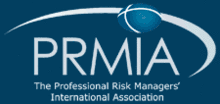Professional Risk Managers' International Association
The Professional Risk Managers' International Association (PRMIA) is a professional organization focused on the "promotion of sound risk management standards and practices globally", and "the integration of practice and theory";[1] it was founded in 2002 as a non-profit.[2] It provides certification and credentialing for professional risk managers, as well as other educational programs and resources.
| Type | Nonprofit Professional Organization |
|---|---|
| Established | 2002 |
| Location | , United States |
| Website | www |
 | |
| Organizational |
|
Board of Directors
Global Council
|
Professional Risk Manager
The Professional Risk Manager (PRM) designation is an international professional certification offered by PRMIA.[3] The designation was first awarded in 2004. The PRM is an "independent validation" of skills within the financial risk management profession, additionally requiring a commitment to professional ethics. The PRM and the Global Association of Risk Professional's FRM are often compared as being the two definitive risk management designations in the industry.[4][5][6]
Candidates are required to pass four exams:
- Finance theory, financial instruments and financial markets (2 hours)
- Mathematical foundations of risk measurement (2 hours: calculus, matrix- and linear algebra, probability, statistics, and numerical methods)
- Risk management practices (3 hours: risk management frameworks [capital allocation, regulatory capital, economic capital, capital adequacy], operational risk, credit risk, counterparty credit risk, market risk, liquidity risk, FTP, ALM)
- Case studies, PRMIA standards of best practice, conduct and ethics, bylaws (1 hour)
The exams are computer-based and the questions are all multiple choice; the passing grade is 60%. The exams can be taken in any order and must be completed over a period of up to two years; they are offered during four testing windows per year, each of three weeks.[7] Individual exam pass rates are 54% for Exam II, 59% for Exams I and III, and 78% for Exam IV;[8][9] with an overall of just over 65%.[8] The PRM program recognizes other professional designations and gives partial credit to "cross-over" candidates, as well as to graduates of select university programs. As of 2019, the above are replaced by two sequential papers, with differing requirements: the first two exams are combined, and the second two.
The recommended reading material is the seven volume Professional Risk Managers' Handbook edited and authored by various practitioners and academics,[10] including Salih Neftci and Paul Wilmott. PRM Online Training is available for those who wish to access customized online learning.
Minimum experience requirements are:[11] four years without a bachelor's degree; two years for those with bachelor's degrees; no requirements for holders of a relevant graduate degree (i.e. MBA, MSF, MQF etc.) or of an accepted professional designation (CFA, CAIA, CQF, etc.). To maintain the designation holder's are required to complete 20 "Continuing Risk Learning" credits each year, to renew their "Sustaining Membership", and to uphold the professional and ethical standards as defined by the PRMIA Standards of Best Practice, Conduct and Ethics.
Certificate programs
PRMIA offers various stand-alone certificate programs designed to give a "focused" and "practical" understanding of various areas of risk management.[12] As for the PRM, the passing score for these is 60%. The computerized tests are offered on all business days. To maintain certification one is required to uphold PRMIA’s professional and ethical standards.
- The Associate PRM covers the core risk management concepts in a less mathematical fashion than the PRM, "allowing non-specialists to interpret risk management information and reports".[13] A single 3 hour exam is required; the recommended text is The Essentials of Risk Management (ISBN 0071429662).
- The Operational Risk Manager Certificate prepares managers to "implement risk assessment initiatives, produce risk management information and understand basic modeling techniques". The exam is 2 hours duration. Preparation is the practitioner-authored Operational Risk Manager Certificate Handbook. ORM Online Training is also available.
- The Credit and Counterparty Risk Manager Certificate focuses on a practical understanding of credit risk analysis frameworks within financial institutions. The program is designed to be relevant to credit risk staff, as well as to financial controllers, and compliance and legal officers. The exam is 2 hours duration. Preparation is the Credit and Counterparty Risk Manager Handbook.
- The Market, Liquidity and Asset Liability Management Risk Manager Certificate covers the areas of market risk, liquidity risk, and asset liability management, and similarly focuses on application in financial institutions. The exam is 2 hours duration. Preparation is the Market, Liquidity and Asset Liability Management Risk Manager Handbook.
Education and professional development
PRMIA offers training and development programs in finance and risk management worldwide.[14] In the classroom, these are through open enrollment courses, and through company-specific, in-house, customized training. Electronically, the offering comprises over 700 short courses and 20 professional courses, numerous live and recorded webinars, as well other "Risk Resources". The association publishes the various books linked to its examination program, as well as others, and Intelligent Risk, its quarterly newsletter.[15]
See also
|
Institutions
|
Certifications
|
References
- "PRMIA Charter | Professional Risk Managers' International Association - PRMIA". Archived from the original on 2016-07-20. Retrieved 2013-06-06.
- See also under Financial Risk Manager#Dispute, as well as GARP Scandal: Global Association of Risk Professionals
- Home | Professional Risk Managers' International Association - PRMIA
- Risk Managers Get Certified – As Profession Grows, Demand Increases for Standards-Setting Examinations. (Archived), Wall Street Journal (April 1, 2010)
- Beyond the CFA and MBA, efinancialcareers.com
- The Rise of the Chief Risk Officer, Institutional Investor (March 2017).
- PRM Candidate Guidebook
- FAQs
- prm-exam, wallstreetmojo.com
- "PRMIA PRM Handbook - Author Biographies". Archived from the original on 2012-01-21.
- prmia.org: Changes to the PRM Exam
- Certificate Programs
- Home | Professional Risk Managers' International Association - PRMIA
- PRMIA Professional Development
- PRMIA Publications